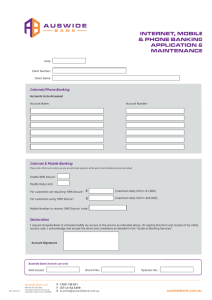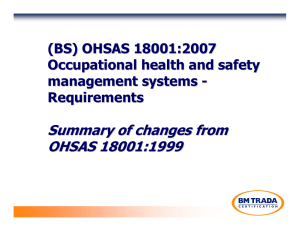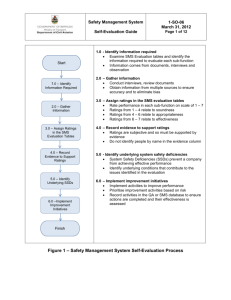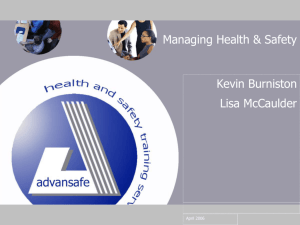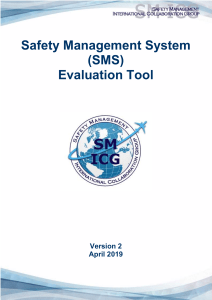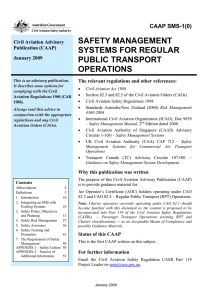The ABCs of SMS – A Simplified Approach
advertisement
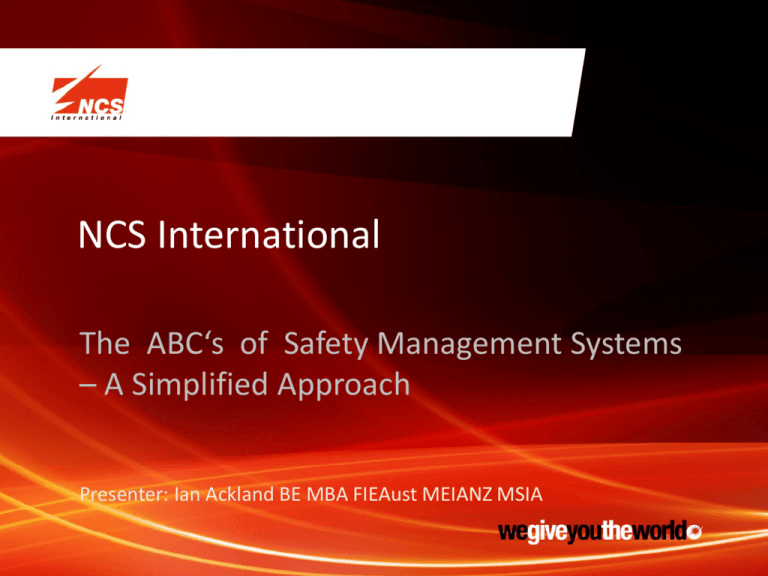
NCS International The ABC‘s of Safety Management Systems – A Simplified Approach Presenter: Ian Ackland BE MBA FIEAust MEIANZ MSIA The ABCs of SMS – A Simplified Approach • • • • • • Outline The Systems Approach Brief description of SMS – why and what SMS Standards and SMS Elements Making a good SMS Safety Key Words from Alphabet Letters Management System Integration 2 The Systems Approach A System is seen as a set of inter-related and interacting Processes A Process has an Input and an Output INPUT OUTPUT 3 Safety Management Systems • Conform to AS/NZS 4801:2001 or OHSAS 18001:2007 • A tool to assist in demonstrating due diligence but not a magic bullet • Follows Plan-Do-Check-Act (PDCA) for continual improvement • Allows consistency of approach to safety and continuity over time and organisational change 4 System Model (after AS 4801; similar for OHSAS 18001) 5 The PDCA Cycle This is an alternate view 6 PDCA Processes (after OHSAS 18001) PLAN: Establish the objectives and processes necessary to deliver results in accordance with the organisation’s OH&S Policy DO: Implement the processes CHECK: Monitor and measure processes against OH&S Policy, objectives, legal and other requirements, and report the results ACT: Take actions to continually improve OH&S performance 7 PLAN - Safety Planning Processes • Top management commitment to begin with • Safety Policy encapsulates the commitment • Identification of Hazards, Risk Assessment and Controls needed (planning) • Legal and Other Requirements • Objectives and Targets • OHS Management Plans (to achieve the objectives and meet legal obligations) • Documentation, Document and Records Control • Emergency Preparedness and Response Plans 8 DO - Implementation • Structure, Responsibility and provision of Resources • Training and Competency • Consultation • Communication about the system internally • Reporting OHS performance internally and externally, as required 9 Implementation cont. • Hazard identification, Risk assessment and Control of risks (practical, operational controls); • Evaluation of this process • Testing Emergency Preparedness and Response • Responding to Incidents and Emergencies • Documentation and Document Control 10 CHECK - Measurement and evaluation • Monitoring and Measurement of key safety parameters (including Health surveillance) • Incident Investigation, Corrective and Preventive Action, and evaluating the effectiveness of actions • Recording and Reporting of the results • OHSMS Audits of the system to verify that the system is effectively operating to plan 11 ACT – For Improvement • Implementing Corrective/Preventive or improvement actions • Evaluation of the effectiveness of the actions • Management Review which can lead to updating policy, objectives, resource and training needs, and determination of improvement to the system 12 Hints and Tips for an SMS • Most systems are too voluminous and complex with their documentation – so go back to basics and use a simple approach to start with (“Occam’s Razor”) • Pictures and diagrams generally convey much more meaning than masses of words (“A picture is worth a thousand words”) • Be sparing with your objectives – don’t try and bite off too much at once 13 A Safety Alphabet • To help with your management of safety, I have created a Safety Alphabet where each letter is matched with one or more safety-related elements 14 A stands for: • ATTITUDE • AWARENESS • ACCEPTANCE • ALIGNMENT • ACTIONS 15 B stands for: • BEHAVIOUR • BELIEF SYSTEMS 16 C stands for: • CULTURE • It also covers – Commitment; – COMMUNICATION – COMPREHENSION – COMPETENCE – COMPLIANCE – COLLABRATION – COOPERATION 17 Further Vowels While on the subject of appropriate alphabetical letters, we can bring in the rest of the vowels! • Expectations; Employee; Emergency; Ergonomics • Implementation; Identification; Incident; Investigation; Instruction; Improvement • Obligations; Observations; “Occam’s Razor” • Understanding 18 The rest of the alphabet • • • • • • • Fitness for work Generic processes Hazards, Health Justification of actions Knowledge of issues Legislation; Learning Muscular-Skeletal issues (“Manual Handling”); Management • Near-hit; Notification • Proactive; Procedures; Processes; Planning • Questioning • Risk; Report; Reactive; Records; Reality check; Responsibility; Response • Supervision; Safety; Simplicity • Training • Verify system adequacy • Warning; Workplace, Work instruction; What & Why? • X-rays and other radiation 19 And finally, • You are the person most responsible for your own safety • Zero harm is the ultimate objective 20 Further Reasons for an SMS • Duty of care and moral responsibility • Expectation from interested parties • Compliance with legal requirements • Risk management • Prevention or reduction of impact of accidents (including costs) • Long term survival of the organisation • Reduce compensation insurance premiums 21 Management System Certification An organisation may choose to have it’s Safety Management System certified against one or both of the standards mentioned above, by an independent third party Certification Body, so as to demonstrate in the public domain that it is compliant with the standard. NCSI is one of many Certification Bodies 22 My Unified Management System Theory • Common to all Management Systems – Safety, Environment, Quality (Customer Satisfaction), Food Safety (HACCP) • Safety Culture – Safety “Mindfulness” • Same for Customer Satisfaction – “customer is king” • Same for Environmental ‘friendliness” and Sustainability • Leadership from the top • Comprehensive risk assessment and control • Ensuing action by all levels in the organisation • Need for understanding what is expected and why • Only as good as the people involved 23 A simple statement of the theory “A successful (Safety) Management System relies upon people in an organisation understanding and managing risk at all levels and in all activities and functions” Keeping things simple is another essential! 24 Another Approach! P+R=S P: People R: Risk Management S: (Safety) Success 25 A Thought to Ponder How well does your organisation stack up to safety? 26 Any Questions? 27 28

